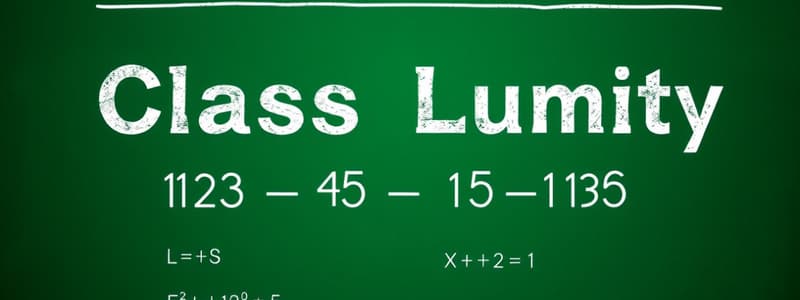Podcast
Questions and Answers
What is the lower class limit?
What is the lower class limit?
- Difference between two lower class limits
- Smallest number in each class (correct)
- Largest number in each class
- Numbers separating classes
What is the upper class limit?
What is the upper class limit?
- Smallest number in each class
- Numbers separating classes
- Mean of the sample
- Largest number in each class (correct)
What is a class boundary?
What is a class boundary?
Numbers separating classes
How is the class midpoint calculated?
How is the class midpoint calculated?
What is the class width?
What is the class width?
What is relative frequency?
What is relative frequency?
What is cumulative frequency distribution?
What is cumulative frequency distribution?
What is a histogram?
What is a histogram?
What does the letter 'n' represent?
What does the letter 'n' represent?
What does the letter 'N' represent?
What does the letter 'N' represent?
What does 'x' with a bar on top represent?
What does 'x' with a bar on top represent?
What does 'u' looking thing represent?
What does 'u' looking thing represent?
What does 'x' with a tilde represent?
What does 'x' with a tilde represent?
What does 'M' represent?
What does 'M' represent?
How is midrange calculated?
How is midrange calculated?
What is the round-off rule?
What is the round-off rule?
What does it mean if a distribution is skewed to the right?
What does it mean if a distribution is skewed to the right?
What does it mean if a distribution is skewed to the left?
What does it mean if a distribution is skewed to the left?
Flashcards are hidden until you start studying
Study Notes
Class Limits
- Lower class limits represent the smallest values in a data class, such as 0 in the range 0-99.
- Upper class limits signify the largest values in a class, with 99 being the upper limit for 0-99.
Classification Elements
- Class boundary is the number that separates two classes, calculated as 99.5 for the classes 0-99 and 100-199.
- Class midpoint is determined by adding the lower and upper class limits, then dividing by 2; for the class 0-99, this yields a midpoint of 49.5.
Class Structure
- Class width is the difference between two lower class limits; for example, it is 100 between classes 0-99 and 100-199.
- Relative frequency is calculated as the class frequency divided by the total frequency, expressed as a percentage for each class.
Frequency Distributions
- Cumulative frequency distribution shows the total frequency for classes up to a certain point, like listing values less than 100, 200, etc., accumulating frequencies from previous classes.
Data Visualization
- Histogram is a type of bar graph that visually represents data without spaces between bars, illustrating frequency distribution.
Statistical Notations
- E-looking thing symbolizes the addition of values in calculations.
- n refers to the number of observations in a sample, while N indicates the size of the entire population.
Averages and Measures
- x̄ (x with a bar on top) denotes the sample mean, calculated as the sum of values divided by n.
- μ (u-looking thing) represents the population mean, found using Ex/N.
- x̃ (x with a tilde) shows the median, a measure effective with datasets that have extreme values.
- M indicates the mode, or the most frequently occurring value in a dataset.
- Midrange is the average of the highest and lowest scores, calculated as (highest + lowest) / 2.
Rounding and Distribution Shape
- Round off rule entails providing one additional decimal place compared to the original data values.
- Skewed to the right indicates a positive skew, where the bulk of the data is at the lower end, creating a curve at the beginning.
- Skewed to the left indicates a negative skew, characterized by a tail on the left, where most data points cluster toward the higher end.
Studying That Suits You
Use AI to generate personalized quizzes and flashcards to suit your learning preferences.




